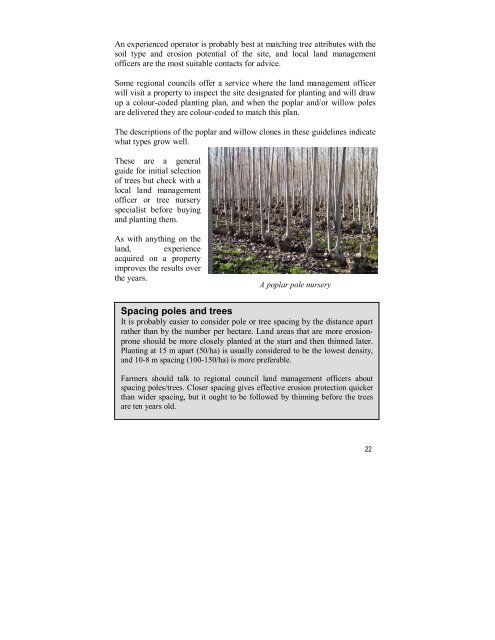Growing Poplar and Willow Trees on Farms, National - FAO
Growing Poplar and Willow Trees on Farms, National - FAO
Growing Poplar and Willow Trees on Farms, National - FAO
Create successful ePaper yourself
Turn your PDF publications into a flip-book with our unique Google optimized e-Paper software.
An experienced operator is probably best at matching tree attributes with the<br />
soil type <str<strong>on</strong>g>and</str<strong>on</strong>g> erosi<strong>on</strong> potential of the site, <str<strong>on</strong>g>and</str<strong>on</strong>g> local l<str<strong>on</strong>g>and</str<strong>on</strong>g> management<br />
officers are the most suitable c<strong>on</strong>tacts for advice.<br />
Some regi<strong>on</strong>al councils offer a service where the l<str<strong>on</strong>g>and</str<strong>on</strong>g> management officer<br />
will visit a property to inspect the site designated for planting <str<strong>on</strong>g>and</str<strong>on</strong>g> will draw<br />
up a colour-coded planting plan, <str<strong>on</strong>g>and</str<strong>on</strong>g> when the poplar <str<strong>on</strong>g>and</str<strong>on</strong>g>/or willow poles<br />
are delivered they are colour-coded to match this plan.<br />
The descripti<strong>on</strong>s of the poplar <str<strong>on</strong>g>and</str<strong>on</strong>g> willow cl<strong>on</strong>es in these guidelines indicate<br />
what types grow well.<br />
These are a general<br />
guide for initial selecti<strong>on</strong><br />
of trees but check with a<br />
local l<str<strong>on</strong>g>and</str<strong>on</strong>g> management<br />
officer or tree nursery<br />
specialist before buying<br />
<str<strong>on</strong>g>and</str<strong>on</strong>g> planting them.<br />
As with anything <strong>on</strong> the<br />
l<str<strong>on</strong>g>and</str<strong>on</strong>g>, experience<br />
acquired <strong>on</strong> a property<br />
improves the results over<br />
the years.<br />
A poplar pole nursery<br />
Spacing poles <str<strong>on</strong>g>and</str<strong>on</strong>g> trees<br />
It is probably easier to c<strong>on</strong>sider pole or tree spacing by the distance apart<br />
rather than by the number per hectare. L<str<strong>on</strong>g>and</str<strong>on</strong>g> areas that are more erosi<strong>on</strong>pr<strong>on</strong>e<br />
should be more closely planted at the start <str<strong>on</strong>g>and</str<strong>on</strong>g> then thinned later.<br />
Planting at 15 m apart (50/ha) is usually c<strong>on</strong>sidered to be the lowest density,<br />
<str<strong>on</strong>g>and</str<strong>on</strong>g> 10-8 m spacing (100-150/ha) is more preferable.<br />
Farmers should talk to regi<strong>on</strong>al council l<str<strong>on</strong>g>and</str<strong>on</strong>g> management officers about<br />
spacing poles/trees. Closer spacing gives effective erosi<strong>on</strong> protecti<strong>on</strong> quicker<br />
than wider spacing, but it ought to be followed by thinning before the trees<br />
are ten years old.<br />
22

















